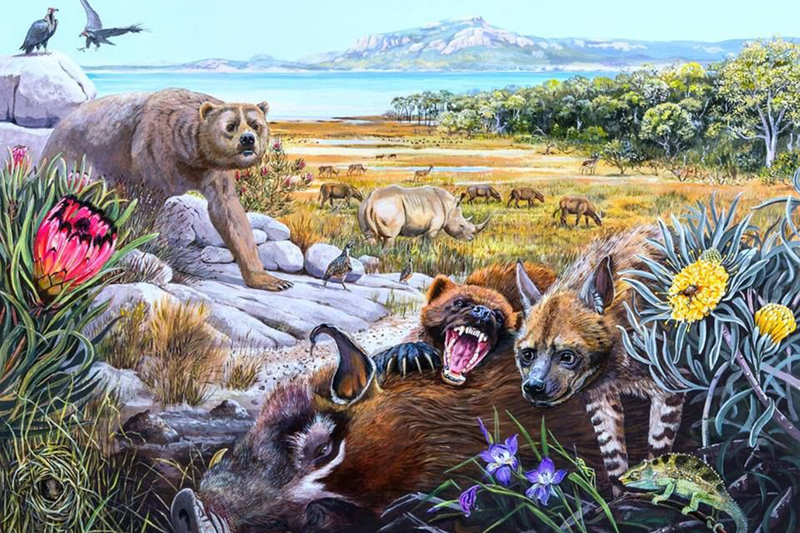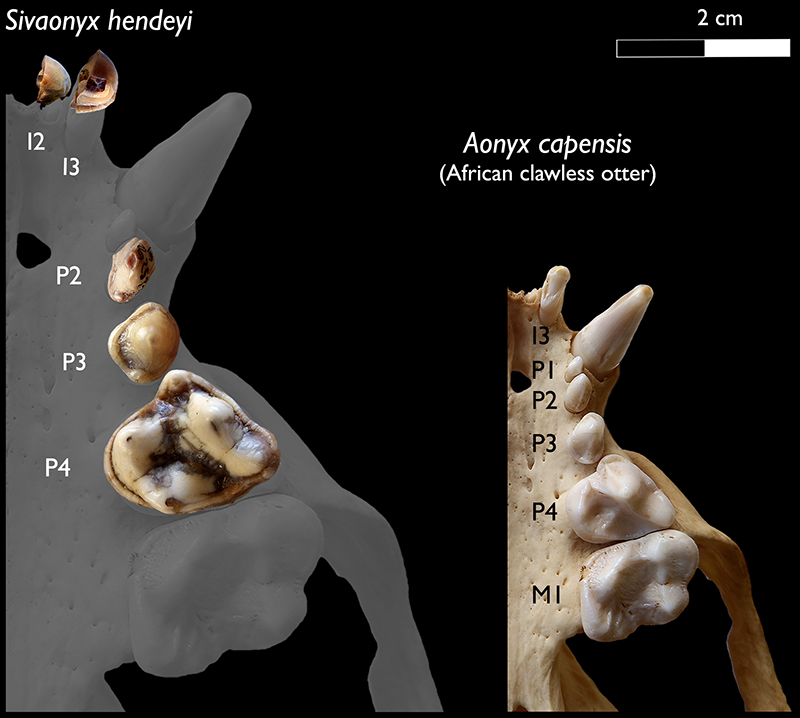When giant mustelids roamed South Africa
01 June 2020 | Story Staff writer. Read time 8 min.
Recent discoveries by scientists at the University of Cape Town (UCT) and Iziko Museums of South Africa show how a wolf-sized otter (Sivaonyx hendeyi) and leopard-sized wolverine (Plesiogulo aff. monspesulanus) lived along South Africa’s West Coast 5 million years ago.
In their research, Dr Alberto Valenciano, a postdoctoral research fellow at Iziko and UCT, and Dr Romala Govender from Iziko, describe the teeth, forelimb and hindlimb skeletons of these carnivores both of which are mustelids – a family of carnivorous mammals that includes weasels, badgers and ferrets.
The fossils, which shed light on the species’ nature and relatedness to other mustelids, represent the first new specimens of the family described from Langebaanweg palaeontological site, on South Africa’s south-west coast, in more than 40 years.
“Our work has led to important new data about the locomotion and diet of the rather poorly known giant otter that is unique to Langebaanweg,” says Valenciano. “In addition, we confirm that Langebaanweg’s wolverine is a different species to that of the large-bodied Plesiogulo botori from Kenya and Ethiopia.”
The fossils described in the newly published research are just a few among the thousands of unpublished fossils in the Cenozoic Palaeontology collections at Iziko. Many of which were excavated between the 1960s and 1980s under the leadership of Dr Brett Hendey of Iziko who oversaw work at the site near Langebaan during that time.
The area, part of the West coast Fossil Park, is home to an array of ancient carnivores, including 20 species of mustelids, bears, seals, jackals, hyenas, sabretooth cats, giant civets and mongoose, and other animals.
“Before I got my postdoctoral fellowship to work in Cape Town with the fossils from Langebaanweg, I knew the location – because it was a globally recognised palaeontological site. But, for me, it was only a faraway place – I’m from Spain – in the tip of Africa with a mixture of species from both continents,” explains Valenciano, whose enthusiasm about the site, fossils and mustelids is clear.
“I never thought that I would have the opportunity to work with – or even see – these fossils in person. So, when I got the postdoc to come here, my mind exploded.
“It gave me the opportunity to have a broader view of South Africa’s extinct carnivores and to expand the brilliant work of Hendey on the carnivores of Langebaanweg.”
Life for mustelids 5 million years ago
What do the new fossils tell us about these giant mustelids that lived 5 million years ago on South Africa’s West Coast?
The researchers propose that the otter’s role in this ancient ecosystem – to which it was unique –was like that of the living African clawless otter and the Asian small-clawed otter today. Although, by comparison, the fossil species was much bigger (around 40 kilograms) and likely less aquatic.
Its robust teeth suggest it ate armoured catfishes, molluscs, crustaceans and even bones.

Around 4 million to 2 million years ago, through the second part of the Pliocene and the early Pleistocene, other species of the Sivaonyx and Enhydriodon genera evolved in Africa. Some of them came to be about the size of modern black bears, exceeding 200 kilograms – the largest mustelids we know of.
“This group of giant otters are all extinct, and their new fossils enable us to unravel their biology and evolutionary relationships,” says Valenciano.
This study confirms that at around the same time there were also two giant wolverine species alive in Africa: the one from Langebaanweg and another one from Kenya and Ethiopia (P. botori). They were later replaced by hyenas, and dog- and cat-like carnivores.
While Valenciano and Govender found the Langebaanweg wolverine to be about the size of a leopard, wolverines today are much smaller – not much bigger than a medium-sized dog. Wolverines 5 million years ago also lived across the world, whereas nowadays they are limited to remote forests and tundra in the northern hemisphere.
“This work highlights that although it is important to unearth new fossils, it is essential that existing collections in museums be actively researched.”
“I am thrilled to hear about these 5-million-year-old giant mustelids that lived on the West Coast of South Africa,” says UCT palaeobiologist Professor Anusuya Chinsamy-Turan, who wasn’t involved in the study. “This work highlights that although it is important to unearth new fossils, it is essential that existing collections in museums be actively researched.”
Govender agrees: “This conclusion brings to the fore the need for new and detailed studies of Langebaanweg fauna housed at Iziko in the Cenozoic Collections. These studies will not only give us insight into the fauna that lived along the West Coast 5 million years ago but will also allow us to study and understand the faunal change that has occurred [since then].”
Although this research helps to shed light on the ecosystem that existed in this location 5 million years ago, it also raises questions. Was this giant otter different to the current African clawless and Asian small-clawed otters? Does the giant Langebaanweg wolverine belong to the Euroasiatic taxa Plesiogulo monspessulanus, or could it be a different species?
Only new fossils unearthed or discovered in museum collections will help answer these questions.
“There are a lot of new things ongoing regarding these carnivores, that you will see soon, so keep tuned!” concludes Valenciano.
- Valenciano A & Govender R (2020) New insights into the giant mustelids (Mammalia, Carnivora, Mustelidae) from Langebaanweg fossil site (West Coast Fossil Park, South Africa, early Pliocene). PeerJ 8:e9221. DOI: 10.7717/peerj.9221
 This work is licensed under a Creative Commons Attribution-NoDerivatives 4.0 International License.
This work is licensed under a Creative Commons Attribution-NoDerivatives 4.0 International License.
Please view the republishing articles page for more information.










